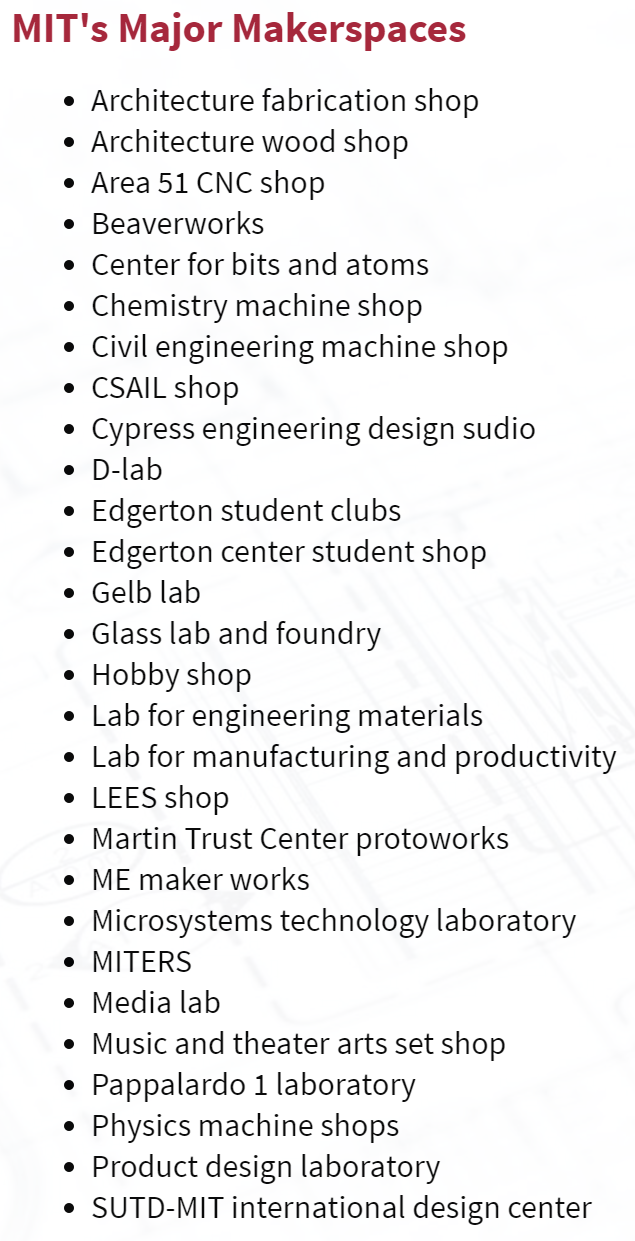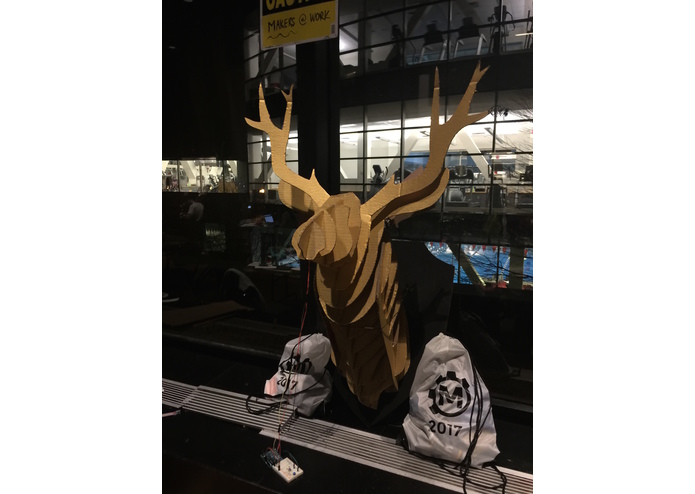Putting The Pieces Together: Hacking at MakeMIT by Krystal L. '17
in which four biological engineers spend 16 straight hours making something
How many biological engineers does it take to make a motorized butterfly that chugs along the top of a giant golden cardboard stag head?

On Saturday, February 25, 2017, four intrepid biological engineers (Cathy, Katherine, Tara, and I) embarked on a daring journey into the world of “making” by signing up for MakeMIT, even though they had no experience whatsoever with anything at all.
MakeMIT is a hardware hackathon on MIT’s campus that brings over 250 students together to hack, make, and create to their hearts’ content for 16 straight hours. Hosted in the student center, the free event supplies all the materials and machinery that a hacker might need to prototype and develop their ideas: Raspberry Pi’s, Oculus Rifts, laser cutters, 3D printers, bandsaws, plywood, 1000 yards of fishing line, and much, much more. Corporate sponsors are also there to provide a few proprietary products for use (i.e. Nvidia Jetsons or Markforged 3D printers), as well as opportunities for consultations and prizes for different categories at the end of the night.
Hacking officially starts at 8:45AM and doesn’t end until 12:30AM the next day. Since the event is held on campus, you are free to come and go as you please, but the limited amount of time, the contagious excitement, and the mountains of free food motivate you to put your head down and stick it out for the 16-hour making marathon.
Despite our lack of prior experience, we thought that this would be a perfect opportunity to learn more about making and hacking, in whatever capacity we could within the short time allotted. At MIT, there is a proud culture of making things (i.e. robotics, software, electronics, enormous wooden contraptions). To parallel this culture, there are countless makerspaces available on campus for student use.

There are also different living communities that are particularly well known for their maker culture. The examples that come to mind are the roller coaster they built at EC and the annual Next Haunt that they host at Next House (an escape the room Halloween experience that they build inside the dorm!). In a sea of mechanical, electrical, and computer science engineers, and other amazing people with amazing talents, sometimes as a biological engineer, I get a niggling feeling that I’m missing out on something important and vital and wholly MIT.
Two things about that.
One: while the maker culture is certainly something important that is cherished here at MIT, it doesn’t fully define MIT. There are so many other things that students here excel at, from the basic sciences to management to the humanities and beyond. We are thinkers and doers and part of what makes the environment here so exciting is the opportunity we have to interact with other people who think differently and who do different things. Be proud of what you do regardless of what anyone else around you is doing, and be proud of your fellow students here for what they do too.
Two: remember that it is never too late to learn something new! Though there were quite a few seasoned veterans at MakeMIT, beginners were also welcomed with open arms. While I won’t be changing majors any time soon, I’m grateful for the opportunity we had to learn some new skills and experience something different.
Below is an account of our MakeMIT experience. Liberties have been taken with the dramatization, though persons and events recounted are all factual. All personifications of inanimate objects are fictional. Any resemblance or likeness to actual personified objects is purely coincidental.
Here is a bonus video that Katherine made, documenting our day and what it was like during the hackathon:
7:03 AM – The student center is empty. Katherine yawns and we question why we are even awake at 7am on a Saturday morning. Shadows dance across the tiled floor of the deserted Dunkin’ Donuts, mocking us with their nimble shadow feet.
7:23 AM – The teams are slowly filing into La Sala de Puerto Rico, a large multipurpose room in the student center, and settling down around one of the many round tables that have filled the room. We stake out a table by the windows with an excellent view of the Z center and people running on treadmills. Four bottles of Soylent and a smattering of swag (a ruler, a T-shirt, a notebook, socks, and a Swiss army knife) smile up at us.
7:26 AM – Bagels, hallelujah. Free breakfast.
8:04 AM – Kickoff. People stand on stage and speak into a microphone. Applause is given in rounds. We are preoccupied with planning the logistics of our day.
8:45 AM – Hacking begins and we’re off! Tara and Cathy start assembling a miniature paper version of the final construct for reference while Katherine and I do some internet sleuthing to find out what supplies we will need for the motorized part of our project.
10:49 AM – We pat ourselves on the back for being masters of internet sleuthing. Equipped with Arduino tutorials, an Arduino, some servos motors, and a handful of wires, we tinker around with the circuits and the code. Tara and Cathy start outlining the actual parts of the sculpture on cardboard. The tiny paper model of the stag head is a beacon of hope for the future of our project. It lies sideways on the table and ponders its own existence while we work around it.
11:15 AM – I eat a bag of fruit snacks. Peach is the best flavor.
12:04 PM – Lunch is served. I munch on tortilla chips and half a steak burrito while contemplating the finer points of angular acceleration and also silently screaming at the little motor because it won’t stop turning in the wrong direction.
12:06 PM – I realize that I typed the wrong number into the code and apologize to the little motor for my unwarranted outburst.
2:02 PM – Tara and Cathy have moved upstairs to one of the work rooms where they begin cutting out the outlined pieces. Katherine and I look at the little motor and admire its spinning-ness. It looks back at us and spins. We have finally figured out how to control its speed and direction. The next step is to design a setup that will move an object in a trapezoidal configuration such that a bird or butterfly will be able to move up and down and across the top of the stag’s head and ears.
2:53 PM – A pile of failed ideas sits forlornly on the table. We hunker down some more.
3:17 PM – 
3:52 PM – The conveyor belt is turning out to be a lot trickier than we had originally imagined. After many failed ideas and attempts, Katherine remembers having seen a box of K’NEXs upstairs in the materials room.
4:01 PM – We sit crisscross applesauce on the carpet and tinker around with the box of K’NEX. Despite the constant wall-hitting and head-banging, we never stop laughing and having fun. Being faced with a problem and having to work together to solve it in the most creative way possible is exhilarating.
4:14 PM – A prototype is birthed! After snapping together some K’NEX sticks and spinning wheels, we head back downstairs to our worktable to hook it up to the little motor. Tara and Cathy are still hard at work cutting the final pieces of cardboard.
5:23 PM – Another roadblock. The conveyor belt is up and running but we still need to figure out a way to attach a bird or butterfly to the moving string without it being caught or flopping backwards. There are a few mentors roaming around offering advice and troubleshooting so we consult with one regarding our troubles. She dispenses some valuable suggestions and we get cracking again.
6:09 PM – Dinner is served. A heaping plate of pad see ew and curry keeps me company as I start cutting out some supplemental cardboard pieces to stabilize our conveyor belt to the sculpture. Tara and Cathy are upstairs assembling the stag head.
9:12 PM – They can’t find the spray paint so Cathy is sitting on a blue tarp hand painting the cardboard gold. Katherine and I are hot glue gunning the final version of our conveyor belt contraption.
10:53 PM – Rivers of epoxy are being applied to the stag head to stabilize it. The gold paint has made it somewhat floppy but it looks epic. My roommate Dora swings by and lends a hand. Tara and Katherine cut out a headboard to mount the stag head on. I start hooking up a simple circuit so our conveyor belt motor can be manually controlled with two buttons.
11:30 PM – As I snack on a red velvet cookie from Insomnia cookies, I feel a wave of fatigue wash over me. The day is drawing to a close and honestly I’m impressed we all made it through without napping or passing out. Tara makes a butterfly out of blue wire. We decide to call the stag head “The Great Prince” in homage to Bambi’s father, The Great Prince of the Forest.
12:19 AM – Oops. The butterfly is too heavy for the conveyor belt and keeps flopping over. Time is running out so in what little time we have remaining, we attempt to lighten the butterfly and readjust the string on the conveyor belt. It is not perfect, but it will have to do.
12:30 AM – And that’s a wrap, folks. The hacking period is over and in 15 minutes, the projects will be open for viewing by the judges and the public.

Ta-da! A giant stag head. You can’t really see it from this angle, but the breadboard wires attach to the butterfly behind the stag’s ears.
12:52 AM – I am in charge of pushing the buttons for the demonstration while Tara holds the stag head up and Cathy and Katherine explain our project. The butterfly wobbles precariously, though we like to pretend that it is fluttering its wings with pride and waving hello. We also wander around the room and admire the work of the other teams. It’s all extremely impressive stuff, especially considering the compressed time frame.
1:30 AM – While shoveling spoonful after spoonful of JP Licks chocolate ice cream into our mouths, we watch the top ten groups present on their work. The sleep deprivation is starting to set in and I can feel a warm blanket of drowsiness wrap around my tired self.
2:37 AM – Sleep beckons. Awards have been announced and the event is officially over so we brave the chilly winter night and head back to our dorms with an enormous golden stag head in tow.
For more information, see the the official website for MakeMIT: https://makemit.org/